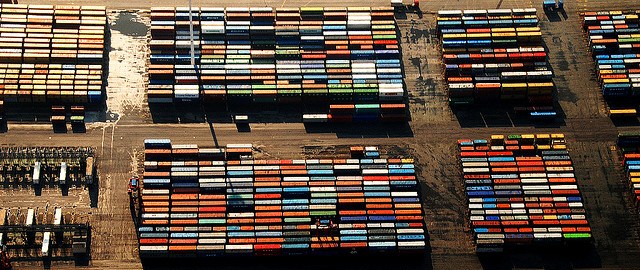One of the reasons to be a first mover is technological leadership. Germany is recognized as such a first mover in wind power, biomass, and solar. New data reveal the extent to which Germany has succeeded, as Craig Morris explains.

The majority of renewable technology produced in Germany is exported. In the photo: Container Terminal in Hamburg. (Photo by Tobias Mandt, CC BY 2.0)
This year, Germany is on target to install more new wind power capacity than ever before. But the solar market will only come in at a quarter of the level of 2012. The government also aims to clamp down on new biogas units, with an annual ceiling of 100 MW of new installations.
That’s the domestic market. And not all of that equipment is made in Germany, anyway. So what happens to the turbines, rotor blades, solar inverters, solar panels, biomass units, and production equipment that the Germans make?
This month, Germany’s Renewable Energy Agency (AEE) published a review of statistics from the various sectors. It turns out that, while the German biogas sector has limited prospects at home, it is on target to increase its exports by more than a third to nearly 890 million euros this year. In combination with lower sales at home, the current export ratio forecast for 2014 – 68 percent – would then increase even further. And despite the boom this year, the German wind sector has an export ratio almost exactly as high at 67 percent.
The AEE provides no estimate for the solar sector’s export ratio, but German solar Association BSW-Solar put the figure at 65 percent for 2013 in its fact sheet on photovoltaics for that year (PDF in German).
In terms of jobs, Germany has roughly 371,000 people employed in the renewables sector, an estimated 230,800 of whom were involved in the manufacturing of equipment, according to the overview published by the German Ministry for Economic Affairs and Energy in May. Of those, roughly 102,000 are needed to handle exports alone, equivalent to 44 percent of the workforce.
But the number of people employed in the renewables sector fell slightly last year and will probably drop once again this year as the solar market continues to shrink. Increasingly, the German renewable sector will have to rely on exports – which is not unusual. For instance, in 2012 only 1.3 million of the 5.4 million cars made in Germany were sold within the country, an export ratio of more than 75 percent.
Furthermore, the renewables sector aimed to be export-driven all along. Go back up to the BSW’s fact sheet, and you will see a target export ratio for solar of 80 percent by 2020.
Nonetheless, the AEE remains concerned about whether German manufacturers and service providers can be successful internationally without a strong domestic market: “In the meantime, other countries have caught up with Germany… and further dynamic domestic growth will allow German firms to continue to be successful abroad.” And then there is the role that Germany’s energy transition plays: “strong growth for renewables in Germany helps convince neighboring countries and those overseas of the Energiewende’s importance.”
Craig Morris (@PPchef) is the lead author of German Energy Transition. He directs Petite Planète and writes every workday for Renewables International.
Hello Craig,
where do German import their renewable energy equipment from? does it have a big share on the local installation?
Regards
Hello Craig,
Could you please explain why Spain failed to export the excessive amount of the solar energy produced? Which was Germany’s secret of success instead of Spain?